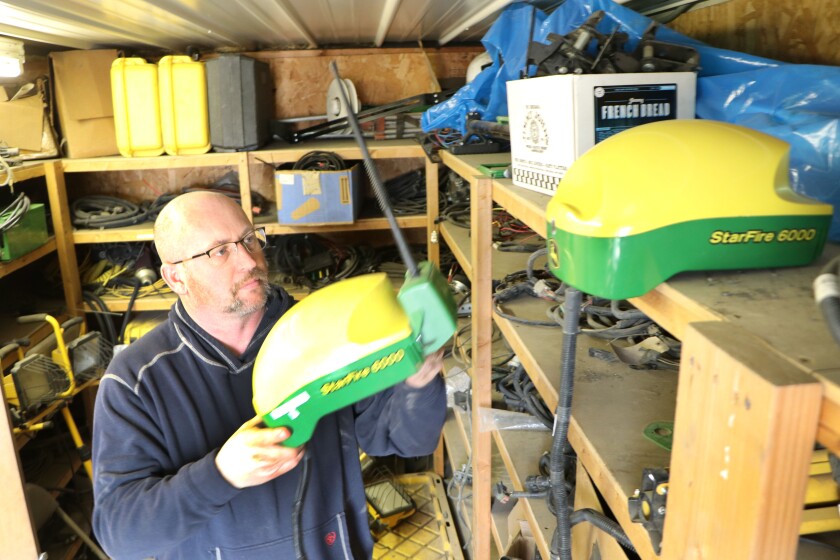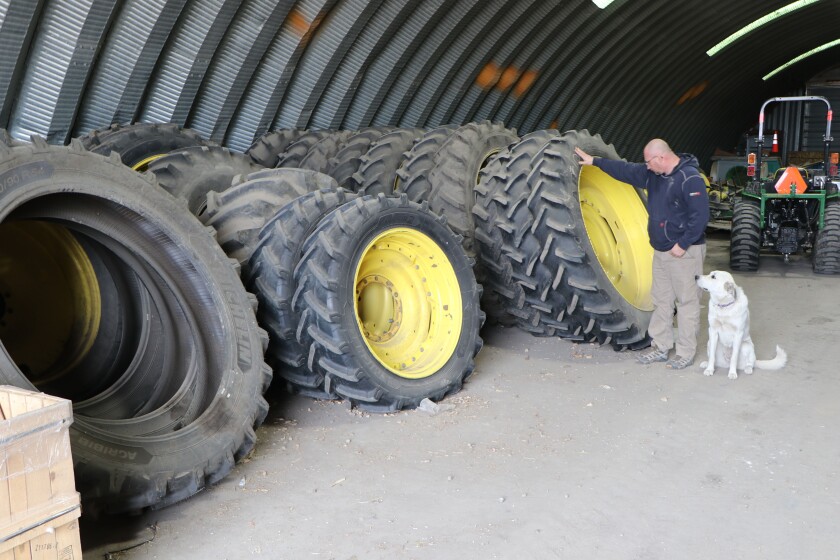Spring planting is among the busiest, most stressful times of a farmer's year.
And now in 2021 across the region, some implement dealers and farmers are navigating a supply shortage of parts, equipment and other materials that has thrown a wrench into producer plans and had dealerships canvassing their own supply sources to get their customers the products they need to get into and stay in the fields.
“My wife went into a dealership to get some parts for the 4-wheeler, and the floor was bare,” Scott Koulesek, District 2 representative for the South Dakota Farmers Union, told the Mitchell Republic recently. “She asked if they were moving, and they said they just can’t get anything in.”
Koulesek, who farms near Wessington Springs, is not alone in experiencing a bit of inconvenience this spring.
Colfax, N.D., farmer Jay Myers had a shaft break on a planter recently.
ADVERTISEMENT
“And there were only three parts in the whole United States and the closest one was just about four hours away. If we were going to order that part, it was going to take until July 29th to get here,” Myers said. “Luckily we were able to just weld up the shaft we had, but we did go get the closest one just to have one on hand.”

Jay Gudajtes, raises sugarbeets, corn, soybeans, wheat and hay with his father, John, and brother Lee at Minto, N.D. He said specialized parts that usually have been delivered in three to six days now might take six to 12 days to arrive. A couple of times in 2020, the Gudajteses drove 165 miles to a dealer at Jamestown, N.D., to get a part that wasn’t immediately available.
“In the past you would wait your two days and get it shipped,” Gudajtes told Agweek. “Now, you can’t rely on those two days; it might be five. You’d just as well might as well go get it, drive there, drive six hours — three hours each way — to get the part. At least you have it.”
A combination of good commodity prices causing high demand and hitches in equipment supply chains has many implement dealers seeing a shortage of products they haven't seen in recent memory. The shortage runs across the board and across various brands, from tractors and other heavy equipment, to smaller tools like four-wheelers to small parts that keep those instruments running and productive.
Just (about) in-time

In recent years, the Gudajteses have gradually shifted toward having more parts on hand, keeping a year’s worth of “wearparts,” or parts that are expected to be replaced in a normal year.
“If we have something go wrong where we have a flat or a blowout, or disaster of some kind, we’re able to just go to our shed and pull it out and put it on our equipment,” he said.
ADVERTISEMENT
Neighbors — even some dealers — sometimes will contact them for emergency supplies.

Delays attributed to COVID-19 haven’t helped, but availability was changing before that. The Gudajtes have had instances where they needed a “very limited, special part — something typically not replaced, something a dealer wouldn’t carry in stock.”
In one case the farm needed a “row-unit controller.” The “RUC” is essentially a computer that processes the row-unit data from the sensor node assemblies located on the row-unit head casting. The information is then sent to the planter main controller to be integrated into the displayed information being sent to the GreenStar Display.

Their dealer got them in touch with people in Moline, Ill., who knew where there was a replacement part available. It was in the middle of planting two years ago and they drove part-way to a truck with the part. There also have been instances in which a dealer would send a plane to Moline, Ill., to get a part.
Gudajtes views the advent of “just-in-time” warehousing system as something that generally helped manufacturers’ bottom lines, and perhaps made parts more affordable, but did so perhaps at the expense of speed in delivery.
Several years ago, Deere & Co. consolidated some of their warehousing, including a Minneapolis area site, which shifted some parts sourcing into a warehouse in Canada. Gudajtes perceives natural delays, crossing an international border. And there’s COVID and biosecurity concerns.
ADVERTISEMENT
“It slows everything down,” he said. ”All of a sudden you start carrying more parts that you didn’t have to before,” he said.

“Any of the components built in China or overseas are delayed for all of the reasons you hear in the news,” he said.
There are reports and rumors of slowdowns at ports and around warehouses where workers break large shipments into deliveries. But it’s hard to sort it all out or pin it down.
“COVID or not, that’s what everybody blames,” Gudajtes said.
The COVID connection

Dan Mettler, owner of Mettler Implement in Mitchell and Menno, S.D., said the issue began as early as last year. While also a dealer of Vermeer agricultural and industrial equipment, he has had a particularly hard time keeping products like Polaris ATVs on the floor after a surge in interest in the outdoors rolled in following the arrival of COVID-19. With sales high last year, there is less ready-to-buy product to be found at dealerships today.
“COVID-19 drove some of that. People wanted to get outdoors. We sell primarily to the farm market in Menno, but quite a bit of outdoor equipment in Mitchell,” Mettler said.
ADVERTISEMENT
Chuck Schams, store manager at St. Joseph Equipment in Eyota, Minn., said the shutdown for COVID-19 precautions played a part.
"There's a shortage in everything, it's just that different things are at different levels," Schams said. "And I'd say this probably started, I think almost within 60 to 90 days after the shutdown."

For some equipment, Mettler said products that would normally be represented by 15 to 30 new units on the floor are likely closer to four or five units now. He said he understood that shortages of several different kinds have led to the delay in delivery — whether it be materials for that equipment or a shortage of workers to assemble it.
When one cog in the production wheel is held up, it can cause a chain reaction, he said.
“The shortages of everything from employees to materials, it’s all kind of coming together to create a bit of a shortage,” Mettler said.
As a co-owner of Mettler Fertilizer in Menno, Turkey Ridge and Tripp, as well, Mettler noted that some fertilizer also was difficult to get after the recent cold snap and the rise in natural gas prices. Nitrogen fertilizer relies heavily on natural gas for production, and when gas prices rose, some natural gas was sold directly to consumers instead of being used for fertilizer.
“It takes three weeks to restart that (fertilizer) production, so they had a big hiccup in production, so we saw that,” Mettler said.
ADVERTISEMENT
Mettler expected to see a return to normal in the upcoming months, but time will tell how quickly dealers will be able to deliver quickly on needed items.
Keeping up with demand

Chris Scott, a co-owner at Scott Supply Company in Mitchell, S.D., a dealer in CaseIH and New Holland products, said his implement is in a similar position to other dealers — at the moment, they are just doing their best to keep up with demand from farmers.
“Equipment has been delayed. Some parts have been delayed, but fortunately we ordered up,” Scott said. “But as far as equipment goes, you can’t get anything on short notice.”
Scott’s company has been utilizing some dealer-to-dealer transfers to help fill orders, but businesses like his are mostly stuck dealing with how fast suppliers can get it to him. Even if a piece of equipment is mostly built and ready to roll off the assembly line, small, normally readily-available parts for it may be hard to find. That means that equipment stays on the line until the needed parts come in.
While there may be a shortage of product on the showroom floor, Scott is optimistic that some balance will return in the coming months, hopefully before harvest in the fall.

“I think our inventory will straighten out soon. What’s causing the stress is what we sold last year that should be here now. It’s just a few weeks late,” Scott said.
ADVERTISEMENT
Mettler agreed that it has been a task trying to have what his customers need when they need it.
“Nothing is sitting on the lot, everything we get in is basically sold,” Mettler said.
The sooner the situation returns to normal for farmers, the better, said Koulesek. When it comes to the farming business, few things are as valuable as good, working equipment and plentiful supplies.
“Common sense says that these manufacturers will be able to pick up the pace and get back on track through the summer. There’s only so long you can stay shut down,” Koulesek said.
Regardless of challenges, there’s no choice about getting the job done, Gudajtes said.
“Making arrangements. Figuring something out. Borrowing it from a neighbor: whatever you’ve got to do to make it work,” he said. “That’s kind of always the way it always goes: if you really need it, you’ll find a way.”
(Emily Beal and Noah Fish of Agweek contributed to this story.)









